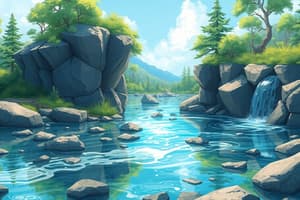Podcast
Questions and Answers
What percentage of the Earth's surface is covered by water?
What percentage of the Earth's surface is covered by water?
- Almost 100%
- Over 50%
- More than 70% (correct)
- About 90%
What is the percentage of freshwater on the planet that is readily available?
What is the percentage of freshwater on the planet that is readily available?
- 5%
- 1%
- 20%
- 10% (correct)
What is the name of the science that deals with the characteristics of freshwater?
What is the name of the science that deals with the characteristics of freshwater?
- Geology
- Oceanography
- Limnology (correct)
- Hydrology
What is the percentage of the Earth's water that is freshwater?
What is the percentage of the Earth's water that is freshwater?
Why is water not a finite resource, despite the Earth's total amount of water being fixed?
Why is water not a finite resource, despite the Earth's total amount of water being fixed?
What percentage of the Earth's total water is freshwater?
What percentage of the Earth's total water is freshwater?
What is the primary source of drinking water for humans?
What is the primary source of drinking water for humans?
What is the term used to describe natural waters with low concentrations of dissolved salts and solids?
What is the term used to describe natural waters with low concentrations of dissolved salts and solids?
What is the approximate percentage of the world's freshwater that is found underground?
What is the approximate percentage of the world's freshwater that is found underground?
What is the term used to describe the mass in grams of dry salts present in 1 kg of seawater?
What is the term used to describe the mass in grams of dry salts present in 1 kg of seawater?
Flashcards are hidden until you start studying
Study Notes
Water Coverage and Availability
- More than 70% of the Earth's surface is covered by water, earning it the nickname "Blue Planet".
- Only 3% of the Earth's water is freshwater, useful for human and animal consumption.
- Most of the freshwater is held in ice and groundwater, leaving only 10% in rivers, lakes, and wetlands, making it a finite resource.
Characteristics of Water
- Hydrology is the study of water.
- Limnology is the branch of science dealing with the characteristics of freshwater.
- Oceanography is the science that deals with about 97% of all Earth's water (ocean).
Distribution of Water on the Earth
- Water is the most abundant compound on Earth, covering nearly three-fourths of the planet's surface.
- More than 97% of the world's total supply of water is found in oceans and is too salty for drinking, irrigation, and most industrial and household needs.
- Approximately 2% of the Earth's water is in the form of glaciers and polar ice caps.
- Most of the rest is found underground (groundwater), and much of that is too difficult or too expensive to tap.
- Less than 0.01% of the Earth's total water is in lakes and rivers, which are the major sources of the world's drinking water.
Freshwater and Groundwater
- Freshwater is the term used to denote natural waters that have low concentrations (less than 500 ppm) of dissolved salts and solids.
- Freshwater includes the waters of lakes, rivers, ponds, and streams.
- Approximately 20% of the world's freshwater is under the soil, in the form of groundwater.
- Groundwater resides in aquifers, which are layers of porous rock that hold water.
- Seawater is often referred to as saline water, with a salinity of the mass in grams of dry salts present in 1 kg of seawater.
Studying That Suits You
Use AI to generate personalized quizzes and flashcards to suit your learning preferences.




